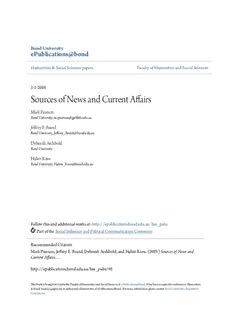
Sources of News and Current Affairs - Bond University PDF
Preview Sources of News and Current Affairs - Bond University
Bond University ePublications@bond Humanities & Social Sciences papers Faculty of Humanities and Social Sciences 5-1-2001 Sources of News and Current Affairs Mark Pearson Bond University, [email protected] Jeffrey E. Brand Bond University, [email protected] Deborah Archbold Bond University Halim Rane Bond University, [email protected] Follow this and additional works at:http://epublications.bond.edu.au/hss_pubs Part of theSocial Influence and Political Communication Commons Recommended Citation Mark Pearson, Jeffrey E. Brand, Deborah Archbold, and Halim Rane. (2001)Sources of News and Current Affairs. . . http://epublications.bond.edu.au/hss_pubs/96 This Book is brought to you by the Faculty of Humanities and Social Sciences atePublications@bond. It has been accepted for inclusion in Humanities & Social Sciences papers by an authorized administrator of ePublications@bond. For more information, please contactBond University's Repository Coordinator. Sources of News and Current Affairs Stage One: The Industry Stage Two: The Audience A research report in two stages conducted by Bond University for the Australian Broadcasting Authority May 2001 Sydney ISBN 0 64227044 9 © Commonwealth of Australia This work is copyright. Apart from any fair dealing for the purpose of private study, research, criticism or review, as permitted under the Copyright Act 1968, no part may be reproduced or transmitted, in any form, or by any means of process, without the written permission of the publisher. Published by Australian Broadcasting Authority 201 Sussex Street Sydney NSW 2000 Printed by Cosmoprint, NSW ii Foreword The Broadcasting Services Act 1992 is unusual in that it states the regulatory intention of Parliament. This is, that ‘different levels of regulatory control be applied across the range of broadcasting services according to the degree of influence that different types of broadcasting services are able to exert in shaping community views in Australia’. The ABA, as the regulator, therefore needs to be able to say with some confidence what degree of influence the different types of broadcasting services exert. A glance at the Act suggests Parliament thought commercial television was the most influential. If that were true in 1992, is it true today? To make the project manageable, the ABA decided to exclude two of the three forms of broadcasting programs the Parliament designates in the Act: entertainment and education, and to concentrate on information, that is, news and current affairs. The task was, in words that Professor Mark Pearson attributes to me in this report, ‘to crack the nut of how news is made in Australia’. To do this, it was necessary to survey both those who produce the news and current affairs, broadly defined, and those who consume them – the public. It was decided to do this both qualitatively and quantitatively. The quantitative surveys are based on random samples, but so ordered as to ensure geographic (and in the case of the news producers – media) balance. There was no point, we decided, in re-inventing the wheel. So both Stage 1 (the news producers) and Stage 2 (the consumers) contain literature surveys. Bond University was selected to undertake the task, and this proved to be an excellent choice. Needless to say, the conclusions are those of the researchers based on their interpretation of the survey results, and do not necessarily reflect the views of the ABA. That said, the result would constitute a marvelous research tool for those interested in that most important institution – our media. It confirms some previous research findings about the media, as well as some perceptions commonly held about them. In addition, there are some surprises. Appreciation for carriage of this project is due to Phyllis Fong, Manager Policy & Research Section at the ABA, who directed it and provided valuable guidance, and staff in the Section, who made important contributions. Professor David Flint Chairman iii SOURCES OF NEWS AND CURRENT AFFAIRS May 2001 iv v SOURCES OF NEWS AND CURRENT AFFAIRS Contents Stage One: The Industry 1 Stage Two: The Audience 261 vi vii Centre for New Media Research and Education Sources of News and Current Affairs Stage One: The Industry Authors: Mark Pearson and Jeffrey Brand, Directors Senior research assistants: Camille Galvin, Halim Rane and Brett Wiley Research assistants: Isabel Andrews, Sarah Haldane, Ambre Langdown and Ashley Walmsley
Description: